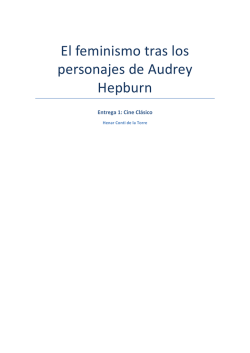
pueden bajar el archivo.
2015 Green Growth the Holly… Canciones inglesas The Holly and the Ivy Tradicional inglesa, origen incierto Gracias a esta canción y a Green growth the holly encontramos el nombre del grupo. Nos gusta mucho la idea de recordar el eterno regreso de la vida adornando la casa con plantas que permanecen verdes en invierno, aunque en nuestras latitudes la época de frío se vive de manera mucho menos dramática. No importa si fueron los romanos, los germanos, los sajones, los druidas o todos ellos quienes iniciaron con esa costumbre; parece que para muchos de nosotros sigue teniendo sentido. The holly and the ivy, when they are both full grown, of all the trees that are in the wood, the holly wears the crown. Oh, the rising of the sun and the running of the deer, the playing of the merry harp, sweet singing in the choir. The holly bears a blossom, as white as lily flow’r, and Mary bore sweet Jesus Christ to be our sweet savior. The holly wears a prickle, as sharp as any thorn, and Mary bore sweet Jesus Christ on Christmas day in the morn’. The holly bears a bark, as bitter as any gall, and Mary bore sweet Jesus Christ for to redeem us all. Salutation Carol Anónimo inglés, s. XV, archivo de Selden, libro 26. John Selden (1584-1654) coleccionó manuscritos de todo tipo, sobre todo de textos legales en latín, inglés antiguo, portugués, español, etc. Su acervo se encuentra actualmente en la Bodleian Library en Oxford y fue enriquecido por varias compras posteriores que realizó la biblioteca y las incorporó a la colección de Selden. Nowell, Nowell, Nowell, Nowell This is the salutation of Angel Gabriel. 1 2015 Green Growth the Holly… 1. Tidings true there be come new, Sent from the Trinity By Gabriel to Nazareth, City of Galilee. A clean maiden, a pure virgin, By her humility Shall now conceive the Person Second in Deity. 2. When that he presented was Before her fair visage, In most demure and goodly wise He did to her homage; And said, “Lady, from heaven so high. That Lordes heritage, For he of thee now born will be, I'm sent on his message. 3. “Hail, Virgin celestial, The meek'st that ever was! Hail, temple of the Deity! Hail, mirror of all grace! Hail, Virgin pure! I thee ensure, Within a little space Thou shalt conceive, and him receive That shall bring great solace. 4. Then bespake the Maid again And answered womanly, “Whate'er my Lord commandeth me I will obey truly.” With “Ecce sum humillima Ancilla Domini; Secundum verbum tuum,” She said, “Fiat mihi.” 2 2015 Green Growth the Holly… Edi Beo Thu Hevene Quene Anónimo inglés, siglo XIII Es un canto de alabanza a María cantado en inglés antiguo. Se trata de una pieza polifónica temprana. Las voces ocasionalmente se entrecruzan y también cantan al unísono varias notas, además de que existen por ahí varias quintas paralelas, las cuales en la Edad Media eran parte de la estética tradicional. Una traducción muy cercana al “tono psicológico” de la canción original se encuentra en este blog: https://suburbanbanshee.wordpress.com/2004/07/26/109088381233694816/ Edi beo thu, hevene quene, Folkes froure and engles blis, Moder unwemmed and maiden clene, Swich in world non other nis. On thee hit is wel eth sene, Of all wimmen thu havest thet pris; Mi swete levedi, her mi bene And reu of me yif thi wille is. Thu asteghe so the daiy rewe The deleth from the deorke nicht; Of thee sprong a leome newe That al this world haveth ilight. Nis non maide of thine heowe Swo fair, so schene, so rudi, swo bricht; Swete levedi, of me thu reowe And have merci of thin knicht. Spronge blostme of one rote, The Holi Gost thee reste upon; Thet wes for monkunnes bote And heore soule to alesen for on. Levedi milde, softe and swote, Ic crie thee merci, ic am thi mon, Bothe to honde and to fote, On alle wise that ic kon. 3 2015 Green Growth the Holly… There Is no Rose Anónimo inglés, c. 1420, biblioteca de Trinity College en Cambridge. Se trata de un canto de alabanza a la Virgen que a la vez relata lo sucedido en la noche del nacimiento de Jesús. Esta pieza contiene algunas reflexiones teológicas con matiz poético. Por ejemplo cantamos: “En esta rosa (la Virgen María) se reunieron cielo y tierra en un espacio pequeño - ¡qué maravilla!” También decimos: “En esta rosa vemos que él es Dios en tres personas iguales en su forma”. There is no rose of such virtue As is the rose that bare Jesu; Alleluia. 1. There is no rose of such virtue As is the rose that bare Jesu; Alleluia. 2. For in this rose contained was Heaven and earth in little space; Res miranda. 3. By that rose we may well see1 That he is God in persons three, Pari forma. 4. The angels sungen the shepherds to: Gloria in excelsis deo: Gaudeamus. Green Growth the Holly… Atribuida a Enrique VIII de Inglaterra (1491-1547), versión corta a 3 voces. Falta la segunda parte presente en el original. Lo que más nos gusta de esta pieza es la amorosa descripción que hace de la naturaleza en otoño e invierno. 1. Green grow’th the holly So doth the ivy Though winter blasts blow na’er so high Green grow’th the holly 4 2015 Green Growth the Holly… 2. Gay are the flowers Hedgerows and ploughlands The days grow longer in the sun Soft fall the showers 3. Fast fall the shed leaves Russet and yellow But resting buds are smug and safe Where swung the dead leaves 4. Green grow’th the holly So doth the ivy The God of life can never die Hope! Saith the holly Mary Sings a Lullaby Leanne Daharja Veich (1970-) Encontramos esta pieza en CPDL (Choral Public Domain Library) al buscar nuevo repertorio y la adaptamos para las características del grupo. Rodolfo hizo varias modificaciones en el acompañamiento. La compositora es de Nueva Zelanda y actualmente vive en Australia. Su obra más conocida es un ciclo de canciones dedicado a las celebraciones paganas del cambio de las estaciones. Cuando escogimos esta canción de cuna, no sabíamos que a ella también le interesa este tipo de repertorio. Su sitio web es http://leanneveitch.com/ Sleep, my pretty one, Sleep my darling, Let the stars be your crown and the night wind your guide. Sleep, my darling, Sleep, my sweet one, Let your eyelids be closed and your sleep bring you peace. Now the sky floods with moonlight, and peace stills the land, And the air rings with bliss, for hope’s hour is at hand. Sleep, my pretty one, Sleep my darling, 5 2015 Green Growth the Holly… Let the angelkind watch you, encircling their wings. Sleep, my darling, Sleep, my sweet one, Let your dreams give you comfort: fear nothing, my love. Now the sky floods with moonlight, and peace stills the land, And the air rings with bliss, for hope’s hour is at hand. Wexford Lullaby Anónimo, época incierta. Letra de John Renbourn. También se conoce como Wexford Carol. Fuentes poco confiables afirman que data del siglo XII. Hay una versión de tono religioso y otra que enfatiza más la canción de cuna que pudiera ser para cualquier bebé. Decidimos grabar esta última. Lulay lulay, my tiny child Too soon you'll know the world so wild Yes all too soon you will be grown And I'll bide here alone, alone. The rushing bellows you shall ride And the light of the North Star will be your guide But yet awhile, I'll have you stay Lulay my tiny child, lulay. For you shall run in meadows green And sport with otters all in the stream And you shall chase the dapple deer And swim with salmon in the waters clear. To pluck the small birds from the sky On the tail of the South wind, you shall fly And take the high hills for your home Blood of my blood, bone of my bone. The moon must sleep beyond the tree So weep sweet maid of Galilee The sun must rise before the cross 6 2015 Green Growth the Holly… To dry your tears and share your loss. The darkest hour of the starless night Must bow to the power of the Eastern light That heals the earth and makes us whole Heart of my heart, soul of my soul. And when at last your course is run Joy of my joy, my little son Beneath the sky you'll stand alone Flesh of my flesh, bone of my bone. Yes you shall stand on the coal-black sands To cross o'er the waters of the Western lands But now I have you at my breast Lulay my sweet one, gently rest. Ding, Dong, Merrily on High La melodía es una danza francesa escrita por Jehan Tabourot (1519–1593). El compositor inglés George Ratcliffe Woodward (1848–1934) le puso la letra que tiene actualmente y la publicó en 1924. Partimos de un arreglo a cuatro voces de Edward L. Stauff para crear nuestra propia versión. Stauff es un personaje interesante porque todavía vive, es muy generoso con sus arreglos y tiene un sitio web muy completo: http://www.christmas-carol-music.org/ En su vida diaria diseña software, pero también ha sido organista en dos iglesias y dirige coros. Esta canción tiene su propia página en Wikipedia: https://en.wikipedia.org/wiki/Ding_Dong_Merrily_on_High Ding dong! Merrily on high in heav’n the bells are ringing. Ding dong! Verily the sky is riv’n with angel singing. Gloria, hosanna in the highest. E’en so here below, below, let steeple bells be swungen and io, io, io by priest and people sungen. 7 2015 Green Growth the Holly… Gloria, hosanna in the highest. Prey ye dutifully prime your matin chime, ye ringers; may ye beautifully rhyme your eve-time song, ye singers. Gloria, hosanna in the highest. Christmas day in the morning Tradicional inglesa, arreglo de Jens Klimek (1984-), un compositor alemán joven que ha ganado varios premios. Esta pieza es una variación de I saw three ships come sailing in o también the As I sat on a sunny bank, dependiendo de las melodías que cada uno asocie con ellas. En los villancicos españoles sucede algo similar. Por ejemplo, las frases “los pastores a Belén corren presurosos” o “en el portal de Belén hacen fuego los pastores” aparecen en varias canciones diferentes. Jens Klimek está en http://www.jensklimek.de/40402/41243.html As I sat under a sycamore tree, I looked me out upon the sea On Christmas day in the morning. I saw three ships assailing there, The Virgin Mary and Christ they bear On Christmas day in the morning. He did whistle and she did sing And all the bells on Earth did ring On Christmas day in the morning. And now we hope to taste your cheer And wish you all a happy New Year On Christmas day in the morning. Halleluja! The Holly and the Ivy (roud 514) Esta melodía alternativa viene de Norfolk y forma parte de un catálogo de música tradicional. Para hacer nuestro propio arreglo nos inspiramos en varias grabaciones. Nosotros la cantamos con una letra alternativa de Karen Deal Robinson. 8 2015 Green Growth the Holly… The holly and the ivy, When they are both full grown, Of all the trees that are in the wood The holly bears the crown. Chorus: Oh the rising of the sun, And the running of the deer. The merry folk arise and greet The dawning of the year. The holly bears a berry As red as any blood, And the ivy grows beneath the snows That blanket all the wood. The holly bears a blossom As white as any flower, And the ivy turns the winter wood To a green and leafy bower. The holly bears a bark As bitter as any gall, And the ivy leaves are shaped like stars In the skies above us all. The holly bears a prickle As sharp as any thorn, And the ivy climbs on hills and towers To greet the Yuletide morn. 9 2015 Green Growth the Holly… Canciones alemanas Jetzt fangen wir zum Singen an Esta canción viene de Salzburgo en Austria. Hay una versión en el dialecto local (la cual intentamos cantar; de ahí viene el aparente error gramatical en el título) y una en alemán estándar. No encontramos mucha información acerca de sus orígenes. Conocí esta pieza en 1993 cuando viví en Austria y la adaptamos a las necesidades del grupo haciendo algunos cambios en la voz del tenor. Jetzt fangen wir zum Singen an, halleluja! Vernehmet all was sich getan, halleluja! A Stern so hell als wie die Sunn geht über’m Buachn roan. Und neamt geht aussa aus der Stub’n, halleluja. Zwoa arme Leut san uns begegn’t, halleluja. Im Dörfl drunt ums Finsterwerd’n, halleluja. Sie suachtn a Nachtquartier und neamand lasst sie ein. Für’s Armsein kann halt neam’d dafür, halleluja! Und jetzt passt’s auf es Leutl all, halleluja! Neahmt’s ab den Huat und tät´s enk gfreu’n, halleluja. Der Gottessohn als kloana Bua wird unter uns bald sein. Er bringt den Friedn und die Ruh, halleluja! Lasset uns frohlocken Eduard Grell (1800-1886) Esta canción salió de un libro de canto para “escuelas de jovencitos e instituciones afines”. Encontré la 76ª edición de 1937 en un botadero. El libro se está deshaciendo, pero contiene material muy interesante, también desde el punto de vista histórico. Grell fue un compositor prolífico y tan conocido que hoy en día tiene página en Wikipedia en alemán, inglés, catalán y sueco. Lasset uns frohlocken! Es nahet der Heiland, den Gott uns verheißen. 10 2015 Green Growth the Holly… Der Name des Herrn sei gelobet In Ewigkeit. Halleluja! Lieb’ Nachtigall, wach auf Apareció por primera vez en el cancionero de Bamberg (sur de Alemania) en 1670: “Despierta, ruiseñor, pajarito hermoso y cántale al niño elegido, pequeñito, recién nacido, muerto de frío”. La letra está llena de diminutivos: “Pajarito, ve al pesebrito a cantarle al niñito tierno...” Lieb Nachtigall, wach auf! Wach auf, du schönes Vögelein auf jenem grünen Zweigelein, wach hurtig auf, wach auf. Dem Kindelein auserkoren, heut geboren, halb erfroren, sing, sing, sing, sing dem zarten Jesulein. Flieg her zum Krippelein, flieg her, geliebtes Schwesterlein, lass tönen hold dein Schnäbelein, sing Nachtigall gar fein. Still, still, weil’s Kindlein schlafen will Popular austriaca del siglo XIX El arreglo proviene de otro de los tesoros de botadero que he podido conseguir: un hermoso libro de canciones de Navidad a dos voces, probablemente editado en la década de postguerra. Se trata de una canción de cuna. Still, still, still, weil's Kindlein schlafen will. Maria tut es niedersingen, ihre ganze Lieb‘ darbringen. Still, still, still, weil's Kindlein schlafen will. Schlaf, schlaf, schlaf, mein liebes Kindlein schlaf! 11 2015 Green Growth the Holly… Die Engel tun schön musizieren, bei dem Kripplein jubilieren. Schlaf, schlaf, schlaf, mein liebes Kindlein schlaf! Groß, groß, groß, die Lieb‘ ist übergroß! Gott hat den Himmelsthron verlassen und muss reisen auf der Straßen. Groß, groß, groß, die Lieb‘ ist übergroß! Canciones en español Buenas noches, San José Chile, arreglo de Waldo Aránguiz. Buenas noches, San José, en compañía de su esposa. Aquí estoy en su presencia Si sirvo pa’ alguna cosa. Donde está, San José, con el Niño y María los tres. Señora Doña María, yo vengo de allá muy lejos. Y a su Niñito de traigo un parcito de conejos. Señora Doña María, yo vengo de la cantera y a su Niñito de traigo un canastito de peras. Con plata de las estrellas Suponemos que este villancico proviene de alguna región de España, pero no pudimos encontrar información fidedigna. 12 2015 Green Growth the Holly… Con plata de las estrellas un manto lleva María. José en sus manos llevaba una varita florida. Venid, venid, venid a Belén a cantar al niño y olé, a cantar al niño y ola, a cantar al niño que está en el portal. María en sus entrañas al hijo de Dios tenía, y en las nevadas montañas el sol del cielo salía. En un pesebre de paja la cuna tuvo el Mesías, la luna y el buey le alientan porque pañales no había. No la debemos dormir Este villancico está en el Cancionero de Uppsala, llamado así porque lo encontraron en la biblioteca de la universidad de Uppsala en Suecia. Pertenece a los evergreens renacentistas que cantan todos los coros. Si buscan esta pieza en YouTube, aparecen más de nueve mil resultados. Estábamos dudando si incluir algo tan trillado en el disco, cuando encontramos una versión menos conocida con una letra “ampliada”, por así decir. Se trata del poema que Fray Ambrosio Montesino o de Montesinos ((¿1444?1512) https://es.wikipedia.org/wiki/Ambrosio_Montesino incluyó en su colección de villancicos Cancionero de diversas obras de nuevo trovadas (1508). Montesino sirvió en la corte de los Reyes Católicos y posteriormente fue nombrado obispo de Sarda en Albania, probablemente un puesto puramente nominal. Por cierto, el título original se escribe (en español de la época) No la devemos dormir, pero decidimos utilizar la ortografía contemporánea para evitar reclamos por parte del público. No la devemos dormir la noche sancta. No la devemos dormir. La Virgen a solas piensa qué hará quando al rey de luz inmenssa parirá: Si su divina esencia temblará, O que le podrá decir… No la devemos dormir la noche sancta. 13 2015 Green Growth the Holly… No la devemos dormir. Qué pensamientos te rigen a tal hora, No menguada, santa Virgen, mi señora. Gloria son que no te agligen. causadora de Dios en carne venir No la devemos dormir la noche sancta. No la devemos dormir. Quando lo parió la dama singular no se puso en blanda cama a reposar; más con pura fe se inflama en adorar al hijo que fue a parir. No la devemos dormir la noche sancta. No la devemos dormir. Velo, qué bonito Villancico colombiano. Velo qué bonito lo vienen bajando con ramos de flores lo van adorando. Ro, ri, ro, ra, San Antonio ya se va. Señora Santa Anna, ¿por qué llora el niño? Por una manzana que se le ha perdido. No llores por una, yo te daré dos, una para el Niño y otra para vos. Los peces en el río Tanto el origen como el significado profundo (si es que lo hay) de esta canción permanecen en la obscuridad. A pesar de haber buscado por todos lados todavía no nos queda claro qué y por qué beben los peces en el río. Si bebieran agua, se acabarían su hábitat. Si beben vino, ¿cómo llegó el vino al agua? ¿O será que ve-ven (ven doble sin haber tomado por estar consternados y/o felices de que nació Jesús)? Lo que nos tranquiliza es que no somos los únicos que nos hacemos esas preguntas. En el 14 2015 Green Growth the Holly… siguiente artículo se expone la hipótesis de que los peces están respirando, pero como tienen la boca abierta, parece que toman agua. http://www.abc.es/ciencia/20121208/abci-peces-beben-201212081606.html Pero mira cómo beben los peces en el río, pero mira cómo beben por ver a Dios nacido. Beben y beben y vuelven a beber, los peces en el río por ver a Dios nacer. La Virgen se está peinando, entre cortina y cortina, los cabellos son de oro, y el peine de plata fina. Pero mira cómo beben… La Virgen está lavando con un poco de jabón, se le han picado las manos, manos de mi corazón. Pero mira cómo beben… La Virgen lava pañales y los tiende en el romero. Los angelitos cantando y el romero floreciendo. Pero mira cómo beben… Canciones en otros idiomas Ecco il Messia Anónimo italiano, época incierta Otro afortunado descubrimiento nada difícil de obtener en la red, escrito para dueto de voces femeninas. No es fácil de cantar, especialmente para dos voces solas resulta muy cansado, pero una vez escuchando el resultado vale la pena. Ecco il Messia 15 2015 Green Growth the Holly… E la madre sua Maria. Venite, alme celeste Su dagli eterni cori: Venite e fate feste Al Signor de’ Signori. Vengan e non dimori La somma gerarchia. Ecco il Messia E la madre sua Maria. Quanno nascette ninno (San) Alfonso María de Ligorio (1696-1787) De esta canción deriva Tu scendi dalle stelle, probablemente tan cantada y tocada en Italia como Los peces en el río y Campana sobre campana en México. El texto está en dialecto napolitano. Quanno nascette Ninno a Bettlemme Era nott'e pareva miezo juorno. Maje le Stelle - lustre e belle Se vedetteno accossí: E a cchiù lucente Jett'a chiammà li Magge all'Uriente. Gaudete, Christus est natus Siglo XVI Esta pieza suena como si hubiera sido escrita en la Edad media, pero apenas aparece en el año 1582 en una colección sueca-finlandesa llamada Piae Cantiones. Hoy forma parte del repertorio de casi todos los grupos de música medieval. Gaudete! Gaudete! Christus est natus ex Maria virgine. Gaudete! Tempus adest gratiae, hoc quod optabamus; carmina laetitiae devote reddamus. Deus homo factus est, natura mirante; mundus renovatus est a Christo regnante. 16 2015 Green Growth the Holly… Ezechiellis porta clausa pertransitur; unde lux est orta, salus invenitur. Ergo nostra contio psallat iam in lustro; Benedicat Domino; salus regi nostro. 17
© Copyright 2025




